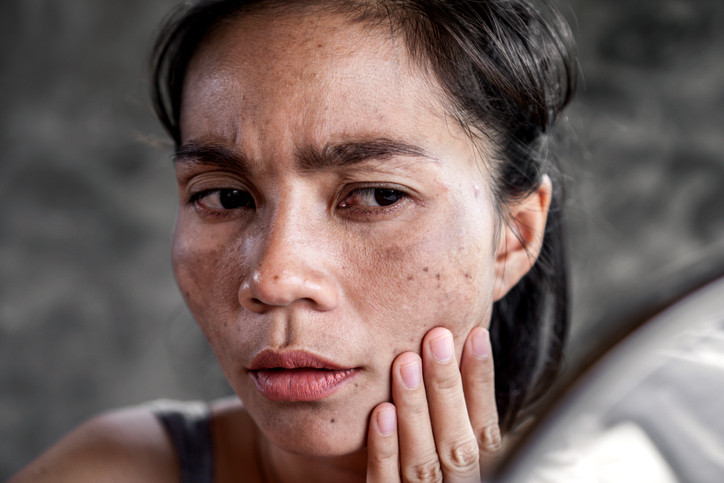Sun-Damaged Skin
What Is It?
Although most people love the warmth and light of the sun, too much sun exposure can significantly damage human skin. The sun's heat dries out areas of unprotected skin and depletes the skin's supply of natural lubricating oils. In addition, the sun's ultraviolet (UV) radiation can cause burning and long-term changes in the skin's structure.
The most common types of sun damage to the skin are:
- Dry skin — Sun-exposed skin can gradually lose moisture and essential oils, making it appear dry, flaky and prematurely wrinkled, even in younger people.
- Sunburn — Sunburn is the common name for the skin injury that appears immediately after the skin is exposed to UV radiation. Mild sunburn causes only painful reddening of the skin, but more severe cases can produce tiny fluid-filled bumps (vesicles) or larger blisters.
- Actinic keratosis — This is a tiny bump that feels like sandpaper or a small, scaly patch of sun-damaged skin that has a pink, red, yellow or brownish tint. Unlike suntan markings or sunburns, an actinic keratosis does not usually go away unless it is frozen, chemically treated or removed by a doctor. An actinic keratosis develops in areas of skin that have undergone repeated or long-term exposure to the sun's UV light, and it is a warning sign of increased risk of skin cancer. About 10% to 15% of actinic keratoses eventually change into squamous cell cancers of the skin.

- Long-term changes in the skin's collagen (a structural protein) — These changes include photoaging (premature aging of the skin because of sun exposure) and actinic purpura (bleeding from fragile blood vessels beneath the skin surface). In photoaging, the skin develops wrinkles and fine lines because of changes in the collagen of a deep layer of the skin called the dermis. In actinic purpura, UV radiation damages the structural collagen that supports the walls of the skin's tiny blood vessels. Particularly in older people, this collagen damage makes blood vessels more fragile and more likely to rupture following a slight impact.
Over a lifetime, repeated episodes of sunburn and unprotected sun exposure can increase a person's risk of malignant melanoma and other forms of skin cancer. As a rule, if you have fair skin and light eyes, you are at greater risk of sun-related skin damage and skin cancers. This is because your skin contains less of a dark pigment called melanin, which helps to protect the skin from the effects of UV radiation.
Symptoms
Sun-damaged skin shows the following symptoms:
- Dry skin — The skin appears dry, flaky and slightly more wrinkled than skin on other parts of your body that have not been exposed to the sun. Dry skin is also one of the most common causes of itching.
- Sunburn — Mild sunburn causes pain and redness on sun-exposed skin. In most cases, there are clear boundary lines where the skin has been protected from the sun by shirt sleeves, shorts, a bathing suit or other clothing. More severe cases of sunburn produce painful blisters, sometimes together with nausea and dizziness.
- Actinic keratosis — An actinic keratosis appears as a small bump that feels like sandpaper or a persistent patch of scaly (peeling) skin that may have a jagged or even sharp surface and that has a pink, yellow, red or brownish tint. At first, an actinic keratosis may be the size of a pimple. Rarely, an actinic keratosis may itch or be slightly tender.
- Long-term changes in the skin's collagen — Symptoms of collagen changes include fine lines, deeper wrinkles, a thickened skin texture and easy bruising on sun-exposed areas, especially the back of the hands and forearms.
Diagnosis
In most cases, your doctor can confirm that you have sun-damaged skin simply by examining the area. Often, a biopsy is done to rule out skin cancer in a patch of actinic keratosis. In a biopsy, a small piece of skin is removed and examined in a laboratory.
Expected Duration
The painful redness of sunburn will fade within a few days, provided that you do not re-expose your injured skin to the sun without using a sunblock or sunscreen. Some sun damage is permanent, although prescription medications, nonprescription remedies and skin-resurfacing treatments may improve the skin's appearance.
Prevention
You can help to prevent sun-damaged skin by taking the following steps:
- Use Mahe Bleu Rejuvenating Skin Care Line twice a day. The new active ingredients with four patented compositions for achieving a radiant complexion. Arbutin Compositions, Multi-Peptide are both powerful antioxidants, they also protect the skin from the harmful effects of overexposure to light, prevents hyperpigmentation and appearance of redness. Water Brightening Program Mask works to provide enhanced luminosity, brightening or lightening to black spot and eyes.

- Apply a sunscreen before you go outdoors. Choose a water-resistant sunscreen that has a sun protection factor (SPF) of 30 or above, with a broad spectrum of protection against both UV-A and UV-B rays. Be sure to reapply often to avoid sweating off or washing off the sunscreen.
- Use a sunblock on your lips. Choose a product that has been specially formulated for the lips, with a sun protection factor of 20 or more.
- Limit your time outdoors when the sun is at its peak (from about 10 a.m. to 3 p.m. in most parts of the continental United States).
- Wear sunglasses with UV light protection.
- Wear long pants, a shirt with long sleeves and a hat with a wide brim.
- Be aware that some medicines and skin care products can increase your skin's risk of UV damage. These include certain antibiotics, as well as some prescription medicines that are used to treat psychiatric illness, high blood pressure, heart failure, acne and allergies. If you are taking a prescription medication and you normally spend a great deal of time outdoors, ask your health care professional whether you should take any special precautions to avoid sun exposure. Also, be aware that certain nonprescription skin care products containing alpha-hydroxy acids can make your skin more vulnerable to damage from sunlight.
To help detect actinic keratoses and other skin abnormalities in their earliest stages, examine your entire skin surface thoroughly every one to two months. Check for patches of discolored or scaly skin, moles, small pearly nodules, sores and other skin abnormalities on all parts of your body, including your scalp and genitals. Use a mirror to inspect harder-to-see areas of your back, shoulders, upper arms, buttocks and the soles of your feet. People who have numerous actinic keratoses should have their skin checked by a doctor at least twice a year.
Treatment
The type of treatment depends on the form of sun damage:
-
Dry skin — Try using Mahe Bleu Rejuvenating Collection that contains at least one of the following ingredients: glycerin, urea, pyroglutamic acid, sorbitol, lactic acid, lactate salts or alpha-hydroxy acids. Using Mahe Bleu Water Brightening Mask to locks moisture in, firms, regenerates cells and boosts radiance. Avoid using alpha-hydroxy acids or other acids on any sunburned skin. Avoid hot baths or hot showers, because these can make your sun-damaged skin even drier. Wash only with warm or cool water, using unscented soap that either has a high fat content or contains glycerin.

- Sunburn — For painful sunburn, try applying cool compresses (such as a cool, wet cloth) to your injured skin, or mist the area with sprays of cool water. If your discomfort continues, take a nonprescription pain medication such as ibuprofen (Advil, Motrin) or aspirin, as long as you do not have a health problem that has caused your doctor to advise you against taking these medications. Your doctor may prescribe stronger anti-inflammatory medication if you have extensive sunburn with severe blistering and pain.
-
Actinic keratosis — The type of treatment that will work best for you depends on many factors, including the number, size and location of your actinic keratoses. Options include:
- Topical fluorouracil — The anticancer drug 5-fluorouracil (5-FU) is applied directly to the skin to eliminate the actinic keratosis.
- Topical imiquimod — This topical treatment up-regulates your own body's defense mechanisms to react against the actinic keratosis.
- Topical diclofenac sodium gel — This topical anti-inflammatory gel is applied twice daily for three months to treat the actinic keratosis.
- Cryotherapy — The actinic keratosis is frozen with liquid nitrogen.
- Chemical peels — A strong chemical solution is used to remove the top layer of skin, with the anticipation that normal skin will grow back later.
- Laser resurfacing — This works in the same way as a chemical peel to remove the top layer of skin, but it uses a laser beam instead of a chemical solution.
- Shave excision — The doctor carefully shaves away the area of abnormal skin. The skin shavings can also be used as a biopsy specimen to check for cancer.
- Photodynamic treatment (PDT) — A light-sensitizing solution is absorbed by the actinic keratosis and then "activated" by light, destroying the actinic keratosis.
Also, because an actinic keratosis is a sign that you are at increased risk of skin cancer, your doctor will schedule regular follow-up skin examinations to check periodically for new areas of abnormal skin.
-
Photoaging and other collagen changes — Although it is not possible to reverse all of the effects of long-term sun damage, your doctor may be able to improve the appearance of your skin by prescribing tretinoin (a derivative of vitamin A) or strong alpha-hydroxy acids that you can apply directly to the skin. Other options include chemical peels; cryosurgery; laser resurfacing; or dermabrasion, in which the outer layer of skin is rubbed away with a special rotating brush or wheel. This allows new skin to grow in place of the old, sun-damaged skin. Your doctor may also be able to inject botulinum toxin (Botox) or fillers such as Restylane, Juvederm or collagen to temporarily reduce wrinkles. As with any cosmetic treatment, discuss risks and benefits with your physician.

When To Call a Professional
Call your primary care physician or a dermatologist (a doctor who specializes in skin problems) if you have any of the following problems:
- Dry skin that doesn't respond to nonprescription treatments
- A severe case of blistering sunburn
- A milder sunburn over a very large portion of your skin, especially if your painful skin makes it hard for you to sleep or to wear clothing
- A persistent scaly patch or nodule anywhere on your skin, or a skin ulcer that does not heal
- Abnormal bleeding under the skin, or skin that bruises very easily
- Any change in moles
Prognosis
Sun damage may result in a permanent cosmetic concern. Some treatments for actinic keratoses can leave a pale (de-pigmented) area of the skin surface. More important than appearance is the long-term impact of sun damage on your chances of developing skin cancer. The more unprotected sun exposure you have during your lifetime, the greater your risk of skin cancer, especially if you have a light complexion.

